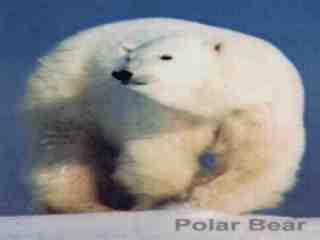:CONTENTS:

Polar
Bears:

The Eskimos call him "Nanook" and credited him with supernatural
powers. Little wonder, too, for this white bear that lives at the
top of the world can appear out of nowhere in a land of endless ice.
Polar bears differ so greatly, both in appearance and habit, from the other
bears of the world that is hard to think of them as related to brown
bears. Until recently scientists even classified ice bears in a group
by themselves.
Evolution
of the Polar Bear
Polar bears (Ursus maritimus) are thought to have evolved from
the brown bears in Siberia during the glacial advance of the mid Pleistocene,
between 250,00 and 100,000 years ago. Their habitat dissected by
glaciers, the bear's ancestors were gradually pushed north onto the sea
ice, where they learned to hunt seals. The harsh environment apparently
stimulated rapid evolutionary changes in these isolated bears. As
they became more carnivorous. Their cheek teeth (carnassials) developed
sharper surfaces for shearing meat into bite sized chunks. Their
long claws, previously used for digging, shortened and became needle sharp
for grasping wriggling prey. The hairs of their fur became hollow
and denser for protection against bitter cold, and, as camouflage in a
white world, their fur became creamy white.
An extinct subspecies of polar bear, called Ursus maritimus
tyrannus, was discovered in London in 1964. From its fossil remains,
we can see that this animal was much larger than present-day polar bears.
Vital
Statistics
Polar bears are among the largest members of the bear family.
Females grow until they are about four years old and attain maximum weights
of about 660 pounds (330 kg). Males continue to grow until about
eight years of age and may weigh from 1,100 to 1,322 pounds (500 to 600
kg) and measure between 8.25 to 11.5 feet (2.5 to 3.5 m0 from nose to tail.
The largest recorded polar bear was a male measuring over 12 feet (3.65
m long and weighing a reported 2,210 pounds (1,002 kg).
The polar bear's stocky body has a longer neck and proportionately
smaller head than other bear's. Its massive forepaws, up to 12 inches
(30 cm) in diameter, are larger than the hind paws and are oar like, with
partially webbed toes for more efficient swimming. The soles of the
feet are covered with dense pads of fur, offering better traction on ice.
The bear's short tail is inconspicuous and its ears are small and furry.
The
Polar Bear's Coat
Fur color varies from pure white to a yellowish hue. Sometimes,
if the light conditions are right, the coat will look gray. The yellowish
shade, often seen in summer, probably results from oxidation by the
sun. In any event, the fur only appears white because it reflects
and scatters visible light ; individual hairs are clear and hollow.
These hollow hair have recently been discovered to act as a kind of ultar


